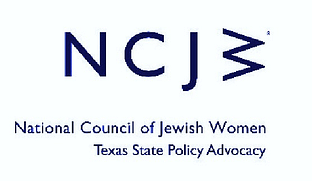GUN VIOLENCE PREVENTION
Gun Violence Prevention
The National Council of Jewish Women (NCJW) is a grassroots national organization of volunteers and advocates who turn progressive ideals into action. Inspired by Jewish values, NCJW strives for social justice by improving the quality of life for women, children, and families and by safeguarding individual rights and freedoms.
The United States has higher rates of gun violence than any other developed nation in the world, with over 36,000 individuals killed every year by guns[i] and over a hundred thousand injured[ii]. The proliferation of, and easy access to, guns has resulted in an epidemic of gun violence. Support for the Second Amendment goes hand-in-hand with keeping guns away from criminals and other dangerous people and with common-sense public safety laws.
We therefore ask our Texas legislators to support the safe storage and purchase of handguns, prevent reckless use of handguns, and educate the public about the risks of firearm suicide.
We urge the Legislature to:
- SUPPORT SAFE STORAGE: SB 158 (Rodríguez), SB 204 ( Huffman), HB 854 (Moody) These bills raise penalties for allowing a child access to a firearm. Under the bills, an adult could be charged with a Class B misdemeanor if a child is found in possession of their firearm. If that child harms him or herself, or another person, it would be a state felony. We also would support increasing the age of access to 18.
- SUPPORT SUICIDE PREVENTION: HB 316 (Howard) This bill would require the Texas Department of Public Safety (DPS) to develop and implement a campaign designed to encourage firearm safety and improve public awareness on the topics of: 1) prevention of firearm accidents involving children, 2) suicide prevention and 3) the safe handling and storage of firearms.
- SUPPORT PREVENTION OF RECKLESS USAGE: HB 86 (Martinez)Anyone caught firing a gun into the air could be charged with a Class A Misdemeanor. If the stray bullet(s) hits someone, they could be charged with a Felony.
- SUPPORT BACKGROUND CHECKS AT GUN SHOWS: HB 1169 (Anchia) and HB 195 (Reynolds) We also ask our legislators to support safer gun buying practices in Texas, including closing the loophole that currently allows Texans to purchase guns at gun shows without a NICS background check. Americans almost universally support background checks[iii] and evidence from states that have already closed this loophole shows that background checks save lives.[iv] Twenty-one states have closed the loophole on background checks, with New Mexico being the most recent one on March 5, 2019.
- SUPPORT PREVENTION OF LIEING ON NICS FORM: HB 95 (Hinojosa) Creates an offense when a prohibited person purchases or attempts (also known as “lie and try”) to purchase a firearm. The bill also requires licensed firearms dealer under 18 U.S.C. Section 923 to report denials to DPS and requires DPS to investigate and refer the case for prosecution, if appropriate.
- OPPOSE ARMING TEACHERS: SB 243 (Creighton), SB 244 (Creighton), and SB 406 (Birdwell). We also know of the dangers of guns around children and asks our legislators to vote AGAINST bills that would allow more guns to be carried by teachers. Introducing guns into our classrooms will make schools even more dangerous for our kids. There is no evidence that arming teachers will prevent mass shootings, although there is evidence that more guns around children and teens creates more danger[v]. We ask you do NOT support any similar bills.
- SUPPORT EXTREME RISK PROTECTION ORDERS: HB 131 (Moody) and SB 157 (Rodriguez): We also are in favor of Extreme Risk Protection Orders, or a Red Flag bill, which can save lives by creating a way for family members and law enforcement to act when a person is in crisis or threatening themselves or others. In 42% of mass shootings, the attacker exhibited similar warning signs before the shooting.[vi] Such laws could also prevent firearm suicides. We ask the legislators, however, to NOT infringe on the current, more restrictive, family violence protective orders for domestic violence abusers and ask that such bills contain family violence exclusion provisions, in order to clarify that they are intended for other purposes.
[i] Centers for Disease Control and Prevention. National Centers for Injury Prevention and Control, Web-based Injury Statistics Query and Reporting System (WISQARS) Fatal Injury Reports. A yearly average was developed using five years of most recent available data: 2013 to 2017. While it is broadly considered to be the most comprehensive firearm fatal injury source, two of the intent categories—Shootings by law enforcement and Unintentional Deaths—are estimated to be greatly underreported. This underreporting is largely due to missing information on death certificates, which may result in misclassification of intent. Multiple media sources and nonprofit groups have tracked shootings by law enforcement but no reliable public database captures unintentional shootings. Intent category averages may not total to yearly average due to rounding.
[ii] Centers for Disease Control and Prevention. National Centers for Injury Prevention and Control, Web-based Injury Statistics Query and Reporting System (WISQARS) Nonfatal Injury Reports. The CDC derives national estimates of nonfatal firearm injuries treated in hospitals from a survey of hospitals known as the National Electronic Injury Surveillance System (NEISS). According to the CDC, some of these estimates may be unstable. Nonetheless, data provided by the CDC is the most comprehensive, publicly-available resource for nonfatal gunshot injuries. To account for fluctuations between years, a yearly average was developed using five years of the most recent available data: 2013 to 2017. Intent category averages may not total to the yearly average due to rounding.
[iii] Pew Research Center. 2018. Gun Policy Remains Divisive, But Several Proposals Still Draw Bipartisan Support. Available at https://pewrsr.ch/2SnLhzn
[iv] Crifasi CK., Meyers JS, Vernick JS, & Webster DW. 2015. Effects of changes in permit-to-purchase handgun laws in Connecticut and Missouri on suicide rates. Preventive Medicine. 2015(79):43–49.
[v] Anglemyer A, Horvath T, Rutherford G. The Accessibility of Firearms and Risk for Suicide and Homicide Victimization Among Household Members: A Systematic Review and Meta-analysis. Ann Intern Med. 2014; 160: 101–110.
[vi] Everytown f=for Gun Safety, Mass Shootings in the United States: 2009-2016, 2017. Available at: http://every.tw/2BvFkXr.

